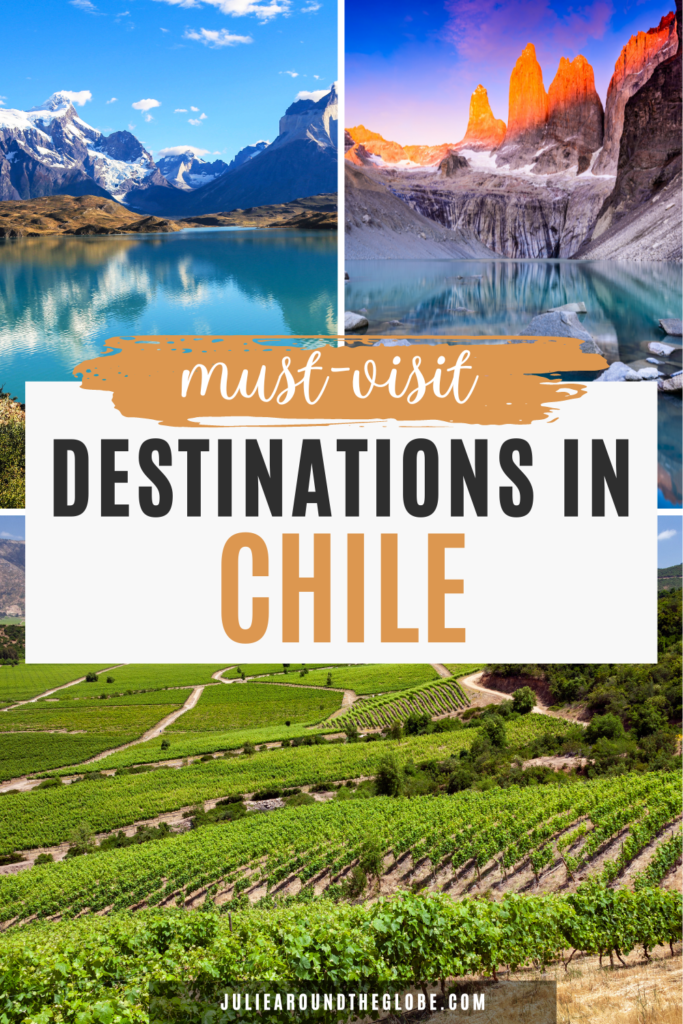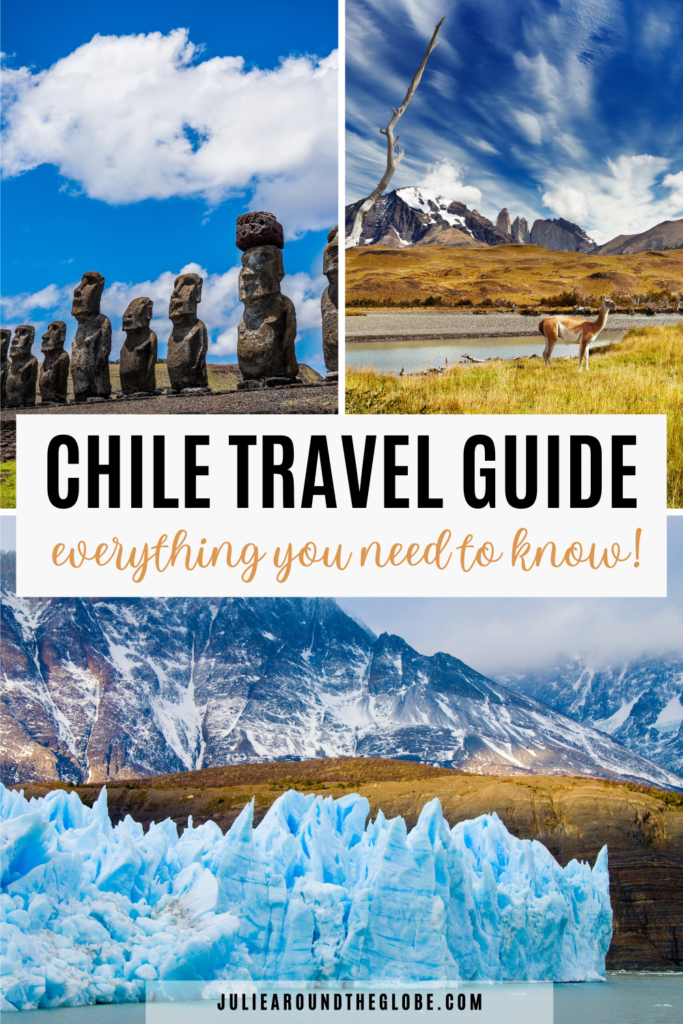12 Most Beautiful Places to Visit in Chile

Last Updated on February 11, 2025
Chile is a country of stunning contrasts, from the arid deserts in the north to the lush forests and glaciers in the south. This unique blend of natural beauty offers a variety of attractions and adventurous activities for any type of traveler.
Whether you’re interested in exploring its unique culture, natural wonders, or beautiful cities, Chile is a destination that should not be missed.
Here are 12 of the most beautiful places to visit in Chile where you’ll make unforgettable memories.
HELPFUL WEBSITES TO HELP YOU PLAN YOUR TRIP
HELPFUL WEBSITES TO HELP YOU PLAN YOUR TRIP
Disclaimer: This post contains affiliate links, which means that if you click on any links and make a purchase, we’ll get a small commission, at no cost to you.
Best Places to Travel in Chile
1. Torres del Paine National Park

Torres del Paine National Park is one of Chile’s most popular and breathtaking destinations. Located in the southern Patagonia region, the park boasts some of the most stunning natural landscapes in the world. The park is home to towering mountains, glaciers, turquoise lakes, and incredible landscapes that will leave you in awe.
Visitors can hike the park’s many trails, which offer a range of difficulty levels, and spot an array of wildlife, including guanacos, foxes, and Andean condors.
The park is also home to the Grey Glacier, one of the few glaciers in the world that is still growing.
With its awe-inspiring beauty and abundance of outdoor activities, Torres del Paine National Park is a must-visit destination for nature lovers and adventurers alike.
2. Easter Island

Easter Island, or Rapa Nui as it is known to its indigenous inhabitants, is a remote and mysterious island located in the middle of the Pacific Ocean, about 3,500 kilometers off the coast of Chile.
This mystical destination is famous for its ancient Moai statues, which are carved from stone and resemble humans with oversize heads. These statues are scattered across the island and date back almost 800 years.
Visitors to Easter Island can explore the archaeological sites and learn about the island’s fascinating history and culture, which is deeply intertwined with the moai and the beliefs of the Rapa Nui. The Rapa Nui people, who are the island’s indigenous inhabitants, have a unique culture and history that is still evident in their customs and traditions today.
In addition to its rich cultural heritage, Easter Island is also home to stunning beaches and volcanic craters, and is a popular destination for hiking. With its rich cultural heritage and stunning natural beauty, Easter Island is a truly unforgettable destination.
Recommended Experience – Private Full-Day Easter Island Highlights
3. San Pedro de Atacama

San Pedro de Atacama is a small town located in the driest desert in the world, the Atacama Desert.
The town itself is filled with traditional adobe buildings, giving it a rustic and charming atmosphere, but the area surrounding San Pedro de Atacama is what visitors come to see.
Surrounded by otherworldly landscapes that include salt flats, geysers, and dramatic canyons, there are plenty of unique things to see and do in the Atacama Desert.
San Pedro de Atacama is a great spot to use as a base when exploring the Atacama Desert.
Walk through the Valle de la Luna, where the landscape reminds you of the moon, then visit the Atacama Salt Flats where you’ll see Andean flamingos feeding in the lagoons.
See the Tatio Geysers, take a dip in the hot springs, and head out to the desert for some of the best star-gazing opportunities in the world.
Also, don’t miss sandboarding at Valle de la Muerte (Death Valley) – an incredible and fun experience!
Recommended Experience – 4-Day Discovery of the Atacama Desert
4. Santiago

Santiago, the capital and largest city of Chile, is located in the central valley surrounded by the Andean Mountains.
The city offers a unique blend of modernity and tradition, with historic landmarks such as the Plaza de Armas, Moneda Palace, and Cerro San Cristóbal standing alongside its skyscrapers, museums, and cultural centers mixed with historic landmarks such as the Plaza de Armas and the Cerro San Cristobal.
Santiago, as expected in the capital city, has plenty of museums, art galleries, and theaters to explore, which showcase the country’s rich history and diverse culture.
The city also has a thriving food scene, with a variety of restaurants serving both traditional Chilean dishes as well as international cuisine.
Nearby Santiago, you’ll find several world-renowned wine regions, including the Maipo Valley, Casablanca Valley, and Colchagua Valley.
These valleys are home to some of Chile’s best wineries, and a wine-tasting tour is an easy day trip from Santiago.
5. Valparaiso
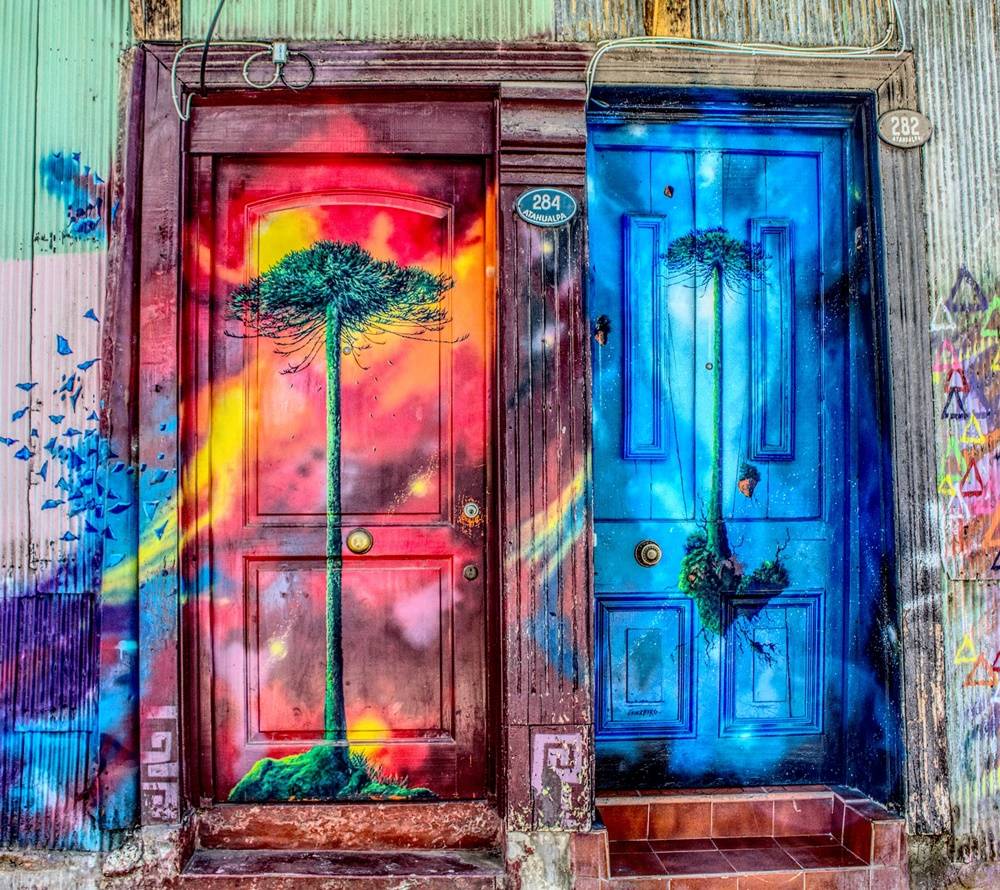
Valparaiso, known as Valpo to the locals, is a colorful and vibrant port city on the central coast of Chile. The city is known for its colorful houses, interesting street art, and steep hillsides.
Valparaiso is one of Chile’s most important ports and before the Panama Canal was built, it was a major stopover for ships traveling between the Atlantic and Pacific Oceans.
Its rich history is evident in the well-preserved colonial buildings and the busy port area. The town was declared a UNESCO World Heritage Site in 2003.
The city is also famous for its street art, which can be found on almost every street, and for its funiculars, which transport locals and visitors up and down the steep hills that Valparaiso is built on.
Being on the Pacific Ocean also means that you’ll enjoy fresh seafood, and tours of the harbor provide excellent views of the city and its famous hills.
6. Chiloé Island
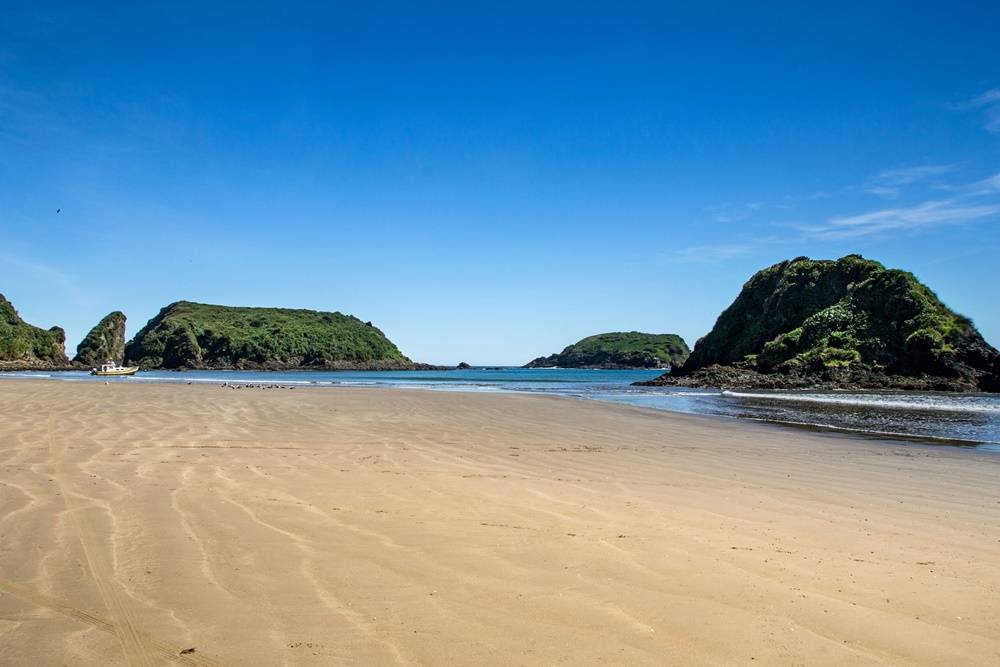
Chiloé Island, Chile’s second-largest island, is located in the southern part of Chile, just off the coast of Chile’s Lake Districts.
The island is famous for its palafitos, or homes on stilts, as well as for its traditional architecture, unique culture, and beautiful landscapes.
Chiloé Island is also well known for its impressive wooden churches, which were built in the 18th and 19th centuries and are now declared a UNESCO World Heritage site.
The island is also home to several national parks and nature preserves, with plenty of opportunities for outdoor activities such as kayaking, hiking, and whale watching.
Chiloé Island is also known for its many types of potatoes – locals will tell you there are over 400 different types! You’ll find potatoes in many dishes, including the curanto, which is cooked underground for hours.
Recommended Experience – Coastal Villages Tour of Chiloé from Castro
7. Elqui Valley
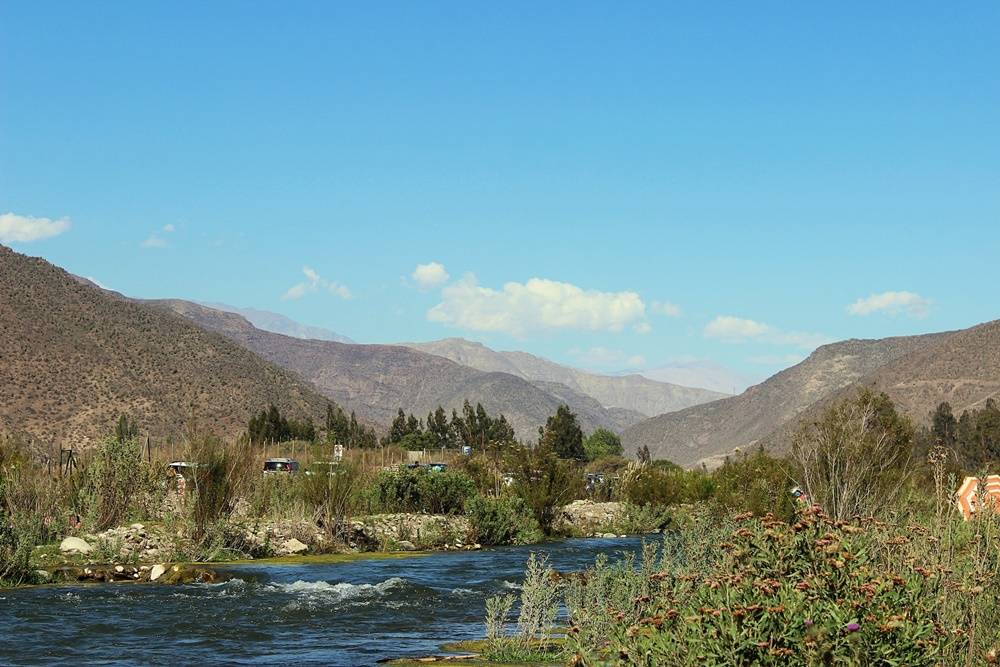
The Elqui Valley is a beautiful region located between Santiago and the Atacama Desert. Known for its clear skies, picturesque villages, and production of Pisco, the Elqui Valley is one of the most interesting places to visit in Chile.
The valley is surrounded by stunning mountain ranges and is famous for its pisco brandy, Chile’s most popular liquor. It’s also known for producing some of the best wines and fruit in the country and is the most northern wine region in the country.
The Elqui Valley is also well-known for its clear skies, which make it an ideal destination for stargazing, and the region has several astronomical observatories.
Recommended Experience – 5-Day Exploration of the Elqui Valley & Humboldt Penguins National Reserve
8. The Hand of the Desert
La Mano del Desierto, or Hand of the Desert, is an impressive statue near Antofagasta in the Atacama Desert.
This unique sculpture depicts a giant hand rising out of the sand and some say it represents mankind’s ability to rise no matter the circumstances, while others say it’s about the isolation and vulnerability in the vastness of the desert.
Either way, it’s an impressive site to see!
9. Iquique
Iquique is a coastal city in northern Chile, known for its stunning beaches and rich history. The historic mining town boasts a unique architectural style, with many historic buildings and monuments dating back to the late 19th and early 20th centuries.
But it’s Iquique’s beaches that are the major attraction. Known for warm waters and excellent surfing conditions, Iquique’s beaches are a great spot to relax for a few days. The surfing here is said to be the best in the country, and many places offer lessons for beginners or experienced surfers.
Or for those who would rather not surf, the sand dunes of the Atacama Desert are perfect for sand boarding.
While many people don’t explore the north of Chile, Iquique is a spot you shouldn’t miss.
10. Colchagua Valley

Chile is well known for its wine and the Colchagua Valley is one of the premier wine-producing regions in the country. This area is known for producing some of the world’s best red wines, and many of the wineries and vineyards offer tours and tastings to visitors.
In addition to its wine production, the Colchagua Valley is also known for its picturesque landscapes that are perfect for outdoor activities such as hiking and horseback riding.
Self-guided cycling tours of the wineries are also a fun way to explore the Colchagua Valley.
11. Chilean Lake District

Chile’s Lake District is a stunningly beautiful region in the foothills of the Andes Mountains in the southern part of Chile. With its breathtaking scenery, vibrant culture, and endless opportunities for adventure, the Chilean Lake District is considered one of the best places to visit in Chile.
Boasting crystal-clear lakes, snow-capped volcanoes, thick forests, and picturesque towns, this area resembles the alpine regions of Europe and is a paradise for outdoor enthusiasts. You’ll find a wide range of activities, such as hiking, kayaking, canoeing, white water rafting, horseback riding, and in the winter, skiing as well.
There are plenty of national parks in this region as well, including Cochamó, which is known as Chile’s “Yosemite”, Vicente Perez Rosales National Park, and Villarrica National Park, which is home to one of Chile’s most active volcanoes.
It’s also worth exploring the charming towns and villages in the area. While the landscape resembles the alpine regions of Europe, you’ll also find many traditions and architecture from Switzerland, Austria, and Germany, as the area was colonized by the Germans in the late 1800s.
Pucón is a must for the outdoor enthusiast and is known for its stunning Villarrica volcano, which towers over the town and is a popular hiking destination. The town is also home to natural hot springs, which are the perfect way to relax after a long day of exploring. Visitors can also enjoy white-water rafting on the Trancura River, horseback riding through the surrounding countryside, and hiking in the beautiful Huerquehue National Park.
The Lake District is also home to the Mapuche, Chile’s oldest and largest indigenous tribe, who have preserved their traditions and customs and kept their culture alive.
12. Carretera Austral

The Carretera Austral, which means “Southern Highway”, is a famous route that stretches over 1,200 kilometers from Puerto Montt to Villa O’Higgins through some of the most stunning landscapes in Chile.
Pass by towering mountains, dense forests, pristine lakes, and glaciers. The Carreterra Austral is a popular destination for outdoor enthusiasts, with several national parks and a wide range of activities, including hiking, kayaking, and mountain biking.
Along the route, at General Carrera Lake, are the stunning Marble Caves, which are actually made from calcium carbonate and have been eroded by water over the years, creating an unusual and beautiful cave system.
The Carreterra Austral continues to the small village of Villa O’Higgins in Patagonia, which is surrounded by snow-capped mountains, turquoise lakes, and countless glaciers.
13. Tierra del Fuego

Visiting Patagonia is an unforgettable experience. Nicknamed the “End of the World”, this rugged and remote region at the southern tip of South America offers stunning landscapes of glaciers, snow-capped mountains, and pristine lakes.
This stunning area is home to colonies of Magellanic and Humboldt penguins, as well as sea lions and dolphins and you may even spot some humpback whales playing in the water.
There you can hike through ancient forests, kayak through pristine waters, or marvel at the glaciers and fjords.
Visiting the Chilean fjords is an awe-inspiring experience that is not to be missed. Explore the fjords by boat, kayak, or even by helicopter, taking in the incredible vistas and getting up close with the abundant wildlife, including penguins, sea lions, and whales.
Chile Travel Tips
How to Get Around Chile
Getting around Chile is relatively easy, and inexpensive compared to North America. Buses are the most common form of public transportation and are widely available throughout the country, with both local and long-distance routes. Chile is a long country though, and given the distance, domestic flights are also a good way to get around.
Several airlines offer regular services between major cities and smaller regional airports. Taxis and rental cars are also available, although driving in Chile can be challenging due to the country’s mountainous terrain and narrow roads.
When is the best time to visit Chile?
The best time to visit Chile depends on the region and activities you plan to do.
Generally, the best time to visit Chile is during the summer months, from December to February, when the weather is warm and dry, and outdoor activities are at their best. This is an excellent time to visit the central region, including Santiago, the wine country, and the coastal cities.
The shoulder season, from September to November and March to May, can also be a great time to visit, with fewer crowds and pleasant temperatures.
However, if you’re interested in skiing or winter sports, the winter months (June to August) are the best time to visit the Andes Mountains.
The southern region of Chile, including Patagonia and Tierra del Fuego, has a more temperate climate and can be visited year-round, although the summer months offer the most daylight hours and the best weather for outdoor activities.
Is Chile an expensive place to visit?
Chile can be an expensive country to visit, especially compared to other countries in South America.
The cost of travel will depend on your travel style and the region you visit. The major cities, such as Santiago and Valparaiso, tend to be more expensive than smaller towns and villages, with higher prices for accommodations, dining, and transportation.
In general, the northern region of Chile is more affordable than the central and southern regions. It’s also worth noting that prices can vary depending on the season, with peak travel times being more expensive.
Overall, while Chile may not be the cheapest destination in South America, it’s still possible to travel on a budget with some planning and flexibility.
What is the currency in Chile?
The currency in Chile is the Chilean peso. Major credit cards are accepted in most places, but it’s also recommended to carry some cash for smaller purchases and markets.
Final Thoughts: Best Places to Visit in Chile
Chile offers a wide range of attractions for tourists, from the natural wonders of Torres del Paine and the Atacama Desert to the cultural and historic landmarks of Santiago and Valparaiso, to the unique Polynesian-Chilean blend of Easter Island.
Each of these destinations is worth a visit and will provide visitors with a memorable and unforgettable experience.
Written by Erin Martin
Save it for later on Pinterest:
